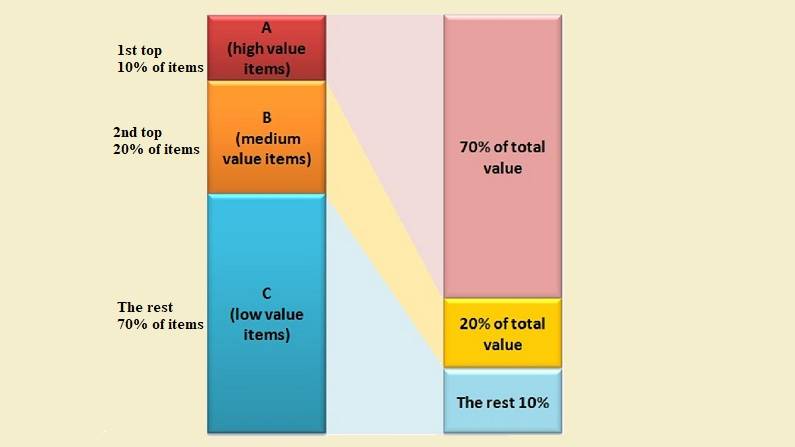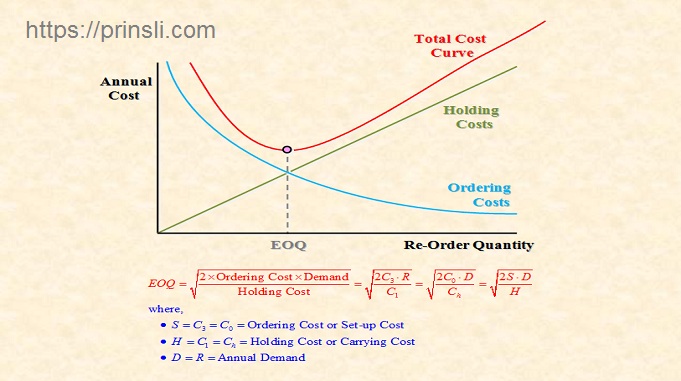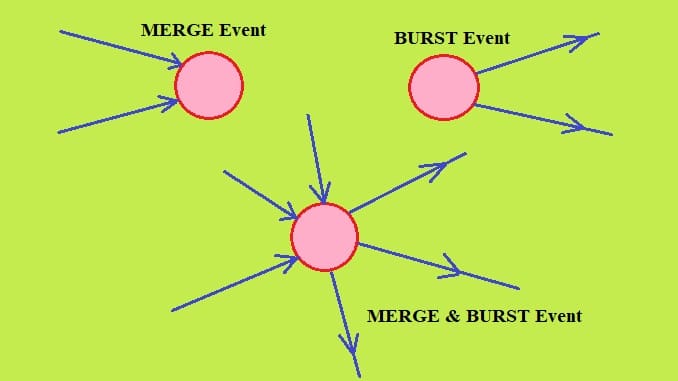
Introduction of ABC analysis in Inventory Management:
Under ABC analysis, the materials are divided into three categories: A, B and C.
- Past experience has shown that almost 10 per cent of the items contribute to 70 percent of the value of consumption and this category is called the ‘A’ Category.
- About 20 per cent of the items contribute about 20 per cent of the value of consumption and this is known as category ‘B’ materials.
- Category ‘C’ covers about 70 per cent of items of materials that contribute only 10 per cent of the value of consumption.
There may be some variation in different organizations and an adjustment can be made in these percentages. The information is shown in the following diagram:
| Class | No. of Items (%) | Value of Items (%) |
| A | 10 | 70 |
| B | 20 | 20 |
| C | 70 | 10 |
- A-B-C analysis helps to concentrate more efforts on category A since the greatest monetary advantage will come by controlling these items. An attention should be paid in estimating requirements, purchasing, maintaining safety stocks and properly storing of ‘A’ category materials. These items are kept under a constant review so that substantial material costs may be controlled.
- The control of ‘C’ items may be relaxed and these stocks may be purchased for the year.
- A little more attention should be given towards ‘B’ category items and their purchase should be undertaken a quarterly or half-yearly intervals.
Advantages of ABC analysis in Inventory Management:
The advantages of ABC analysis in inventory management are as follows:
(i) Reduction in investment:
Under ABC analysis, the materials from group ‘A’ are purchased in lower quantities as much as possible. With this, the effort to reduce the delivery period is also made. These in turn help to reduce the investment in materials.
(ii) Strict control:
Under ABC analysis, strict control can be exercised on the materials in group ‘A’ that have a higher value.
(iii) Minimum storage cost:
Since the materials from group ‘A’ are purchased in lower quantities as much as possible, it reduces the storage cost as well.
(iv) Saving in time:
Since a signification effort is made for the management of the material from group ‘A’, it helps to save time as well.
(v) Economy:
This method is economical since equal time and labour are not needed for all types of materials.
Disadvantages (Limitations) of ABC analysis in Inventory Management:
The disadvantages of ABC analysis in inventory management are as follow:
(i) ABC analysis will not be effective if the materials are not classified into groups properly.
(ii) It is not suitable for an organization where the costs of materials do not vary significantly.
(iii) There is no scientific base for the classification of material under ABC analysis.
(iv) The classification of the materials into different groups may lead to extra costs. Hence, it may not be suitable for a small organization.
(Source – Various books of college library)
Copyrighted Material © 2019 - 2024 Prinsli.com - All rights reserved
All content on this website is copyrighted. It is prohibited to copy, publish or distribute the content and images of this website through any website, book, newspaper, software, videos, YouTube Channel or any other medium without written permission. You are not authorized to alter, obscure or remove any proprietary information, copyright or logo from this Website in any way. If any of these rules are violated, it will be strongly protested and legal action will be taken.






Be the first to comment